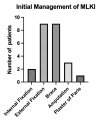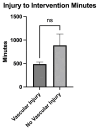Outcomes of Knee Dislocations and Subluxations in Polytrauma Patients at a Major Trauma Center
- PMID: 39749064
- PMCID: PMC11694424
- DOI: 10.7759/cureus.75024
Outcomes of Knee Dislocations and Subluxations in Polytrauma Patients at a Major Trauma Center
Abstract
Background This is a retrospective service evaluation of outcomes of polytrauma patients sustaining knee dislocations and subluxations within a major trauma center (MTC). Polytrauma patients with knee dislocations are complex to manage and often sustain multiple life-threatening injuries. Although treatments have progressed, no consensus remains on management timing and strategy. Methods Information on knee dislocations and subluxations sustained in polytrauma patients was extracted using the Trauma Audit and Research Network database. This included demographic information on age, gender, and BMI, as well as information regarding their initial assessment in the emergency department (ED), including the Glasgow Coma Scale, Injury Severity Score, mechanism of injury, and time spent in ED. Associated injuries to the knee joint, including vascular compromise, associated bony injury, and ligamentous damage, were extracted from the patient notes. The management of these injuries was also examined, including the operative time, whether they required single or multistage surgery, and post-operative range of movement. Results Over eight years, from 2013 to 2021, there were a total of 187 polytrauma patients sustaining knee injuries, of which 17 had a knee joint dislocation and seven had a knee joint subluxation. The mean age of the patients was 46, their BMI was 28, and 19 out of the 24 had been involved in a vehicle incident or collision. In 80% of patients, there was an associated fracture of the lower limb, and just under half of patients had associated ligamentous injury (11 patients), with one-third of the patients sustaining an associated vascular injury (eight patients). One-third of the patient cohort was managed conservatively in a brace. Of the remaining, 12 required operative fixation, three underwent an amputation, and one was managed non-operatively with plaster of Paris. The mean operative time was 80 minutes in patients with vascular injury compared to 159 minutes without. This could be attributed to the more complex injuries in polytrauma that accompany a vascular injury. The median operative time was 71 minutes and 80 minutes, respectively. Within this study, the distance to the MTC did not appear to be a key determinant of amputation, though the low patient numbers limit the statistical power of this study. Conclusions Polytrauma patients are a complex cohort, often sustaining multiple injuries that require operative management with a multidisciplinary approach. Knee dislocations are a rare injury and are high energy, primarily caused by vehicle collisions in a polytrauma setting. A third of patients have an associated vascular injury, and 80% have an associated fracture, which is a much higher rate than is observed in a non-polytrauma setting.
Keywords: knee dislocation; knee injuries; knee trauma; multiple trauma; polytrauma; traumatic knee dislocation.
Copyright © 2024, Gompels et al.
Conflict of interest statement
Human subjects: Consent for treatment and open access publication was obtained or waived by all participants in this study. Cambridge University Hospitals NHS Trust issued approval N/A. This study was registered as a service evaluation with CUH NHS Trust and approved by the audit lead at the trust for publication. Animal subjects: All authors have confirmed that this study did not involve animal subjects or tissue. Conflicts of interest: In compliance with the ICMJE uniform disclosure form, all authors declare the following: Payment/services info: All authors have declared that no financial support was received from any organization for the submitted work. Financial relationships: Jai Rawal declare(s) personal fees from DePuy Synthes. Educational agreement. Other relationships: All authors have declared that there are no other relationships or activities that could appear to have influenced the submitted work.
Figures




Similar articles
-
[Diagnosis, Treatment and Complications of Knee Dislocation: a Retrospective Study].Acta Chir Orthop Traumatol Cech. 2021;88(2):107-116. Acta Chir Orthop Traumatol Cech. 2021. PMID: 33960923 Czech.
-
[Traumatic knee dislocation with popliteal vascular disruption: retrospective study of 14 cases].Rev Chir Orthop Reparatrice Appar Mot. 2006 Dec;92(8):768-77. doi: 10.1016/s0035-1040(06)75945-1. Rev Chir Orthop Reparatrice Appar Mot. 2006. PMID: 17245236 French.
-
Epidemiology and outcomes of traumatic knee dislocations: Isolated vs multi-trauma injuries.Injury. 2018 Jun;49(6):1183-1187. doi: 10.1016/j.injury.2018.02.016. Epub 2018 Feb 21. Injury. 2018. PMID: 29576239
-
Traumatic Dislocation of the Proximal Tibiofibular Joint: A Systematic Review and 10-year Experience From a Level 1 Trauma Center.J Am Acad Orthop Surg Glob Res Rev. 2022 May 1;6(5):e21.00105. doi: 10.5435/JAAOSGlobal-D-21-00105. J Am Acad Orthop Surg Glob Res Rev. 2022. PMID: 35503776 Free PMC article.
-
Management of acute knee dislocation with vascular injury: the use of the external fixator. A systematic review.Arch Orthop Trauma Surg. 2022 Feb;142(2):255-261. doi: 10.1007/s00402-020-03684-0. Epub 2020 Nov 22. Arch Orthop Trauma Surg. 2022. PMID: 33222023
References
-
- Acute knee dislocation: review of an elusive entity. Kapur S, Wissman RD, Robertson M, Verma S, Kreeger MC, Oostveen RJ. Curr Probl Diagn Radiol. 2009;38:237–250. - PubMed
-
- 10-year review of knee dislocations: is arteriography always necessary? Hollis JD, Daley BJ. https://journals.lww.com/jtrauma/fulltext/2005/09000/10_year_review_of_k.... J Trauma. 2005;59:672–675. - PubMed
-
- Ultra-low-velocity knee dislocations. Azar FM, Brandt JC, Miller RH 3rd, Phillips BB. Am J Sports Med. 2011;39:2170–2174. - PubMed
-
- Arterial injuries associated with complete dislocation of the knee. Kaufman SL, Martin LG. Radiology. 1992;184:153–155. - PubMed
LinkOut - more resources
Full Text Sources
Medical
